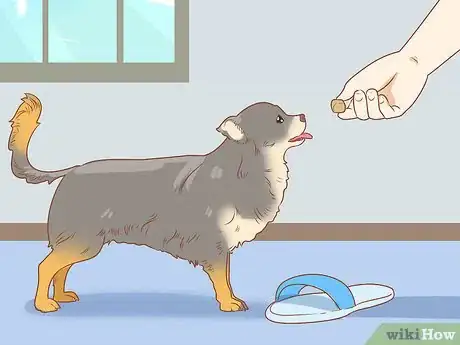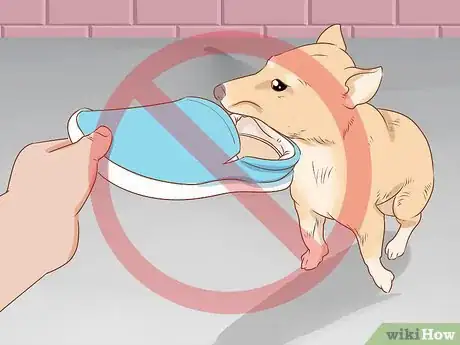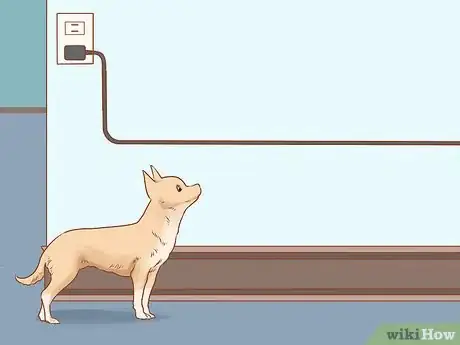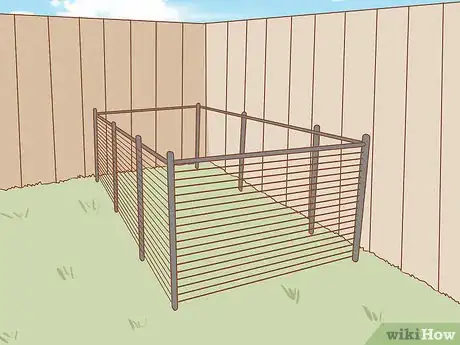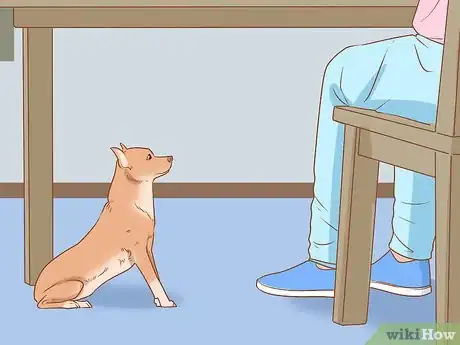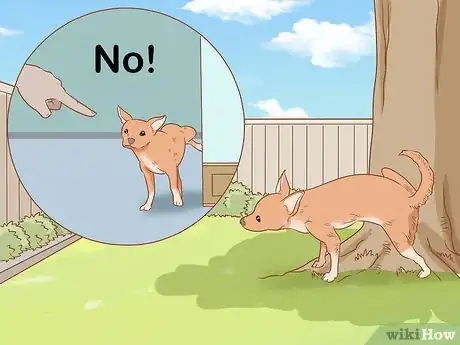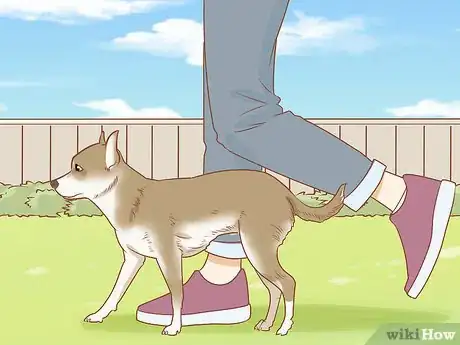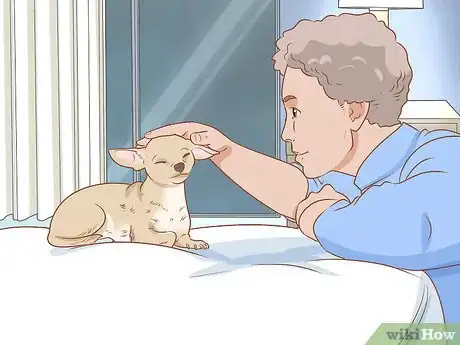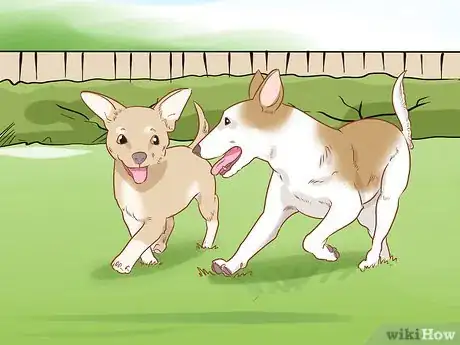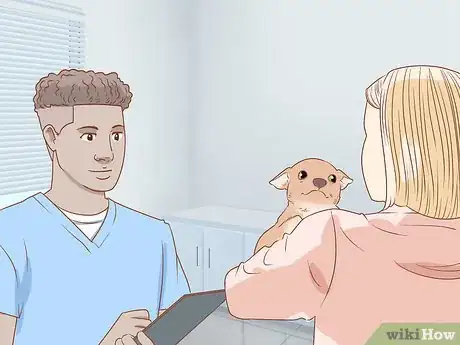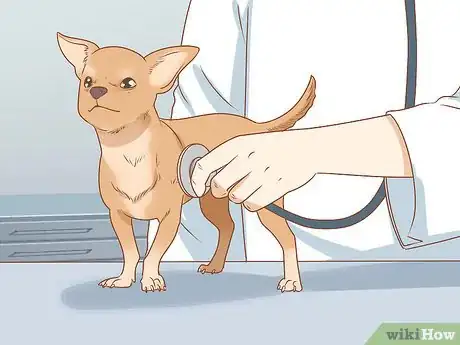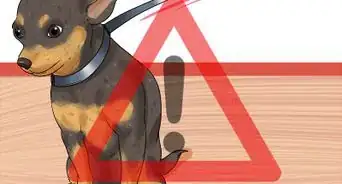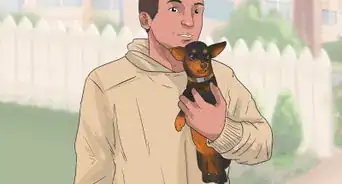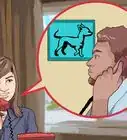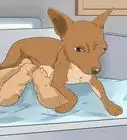This article was co-authored by Pippa Elliott, MRCVS. Dr. Elliott, BVMS, MRCVS is a veterinarian with over 30 years of experience in veterinary surgery and companion animal practice. She graduated from the University of Glasgow in 1987 with a degree in veterinary medicine and surgery. She has worked at the same animal clinic in her hometown for over 20 years.
There are 19 references cited in this article, which can be found at the bottom of the page.
This article has been viewed 34,615 times.
Chihuahuas have a reputation as yappy, high-strung dogs, but they can be loving and faithful pets. As long as you take the time to work with your Chihuahua on its issues, you should be able to correct most of the problems you have with it, such as chewing, boredom, or bathroom issues. You are your Chihuahua's best friend, and by making sure you fulfill its needs, you can have a happy and healthy pet.
Steps
Working on Chewing Issues
-
1Give your Chihuahua appropriate toys when it chews on the furniture. Those little teeth can do considerable damage to your home if they're left unchecked! The solution is fairly simple. When you see your dog chewing on something it shouldn't, offer it a fun toy instead. It will usually opt for it and leave your furniture alone.[1]
- Once your Chihuahua grabs onto the toy, tell it what a good dog it is! The more praise you offer, the more your dog will get the idea that playing with the toy is a good idea.
- Make sure to get toys that are small enough for your Chihuahua's mouth. Look for toys for small dogs. Rope toys, plush toys made from tough materials, and rubber squeak toys are all good options. Make sure to always supervise your dog with chew toys, as it could chew off a piece big enough to choke on.
- Puppies may have sore gums from teeth coming in. Offer them a wet, frozen washcloth, which should help numb the pain. Keep an eye on your pup so it doesn't swallow any of the washcloth.[2]
-
2Trade treats for inappropriate items. When your Chihuahua has something in its mouth you want it to drop, distract it with a treat instead. Oftentimes, your dog will drop the shoe or whatever it has in its mouth to take the treat.[3]
- As your dog catches on to this trick, add a command like "Give" or "Drop."
- Make sure you only give your dog a treat when it lets go of the object. That way, your dog will learn that it’s being rewarding for dropping the item rather than being rewarded for chewing on it.
Advertisement -
3Avoid giving your dog items similar to things you don't want it to chew. In other words, don't give your Chihuahua an old shoe to chew on and then expect it not to chew your other shoes. Make a clear distinction between toys and non-toys.[4]
- Similarly, don't offer your Chihuahua things like socks. If you have small kids in the house with stuffed animals, you may not want to give your chihuahua plush toys.
-
4Move wires and other valuables out of chewing range. Because these dogs are so small, it's relatively easy to put most things out of their reach. Pick shoes up off the floor, for instance, and move wires up off the ground to discourage your Chihuahua from chewing on them.[5]
- To deal with wires, hide them under cable shields or attach them to the wall with a kit. You could also block off areas with wires using furniture. For instance, you could put bookcases on each side of your entertainment center to keep your Chihuahua from getting behind it to the wires.
- Also, keep an eye on Chihuahuas when they're young, as they're more likely to chew when they're puppies.
-
5Spray bitter apple on things you don't want to be chewed. Dogs don't like the taste of this spray, and it's non-toxic. Simply spritz it on things like furniture, wires, and other items your Chihuahua tends to chew on. You may need to apply this spray as often as once a day until your dog learns not to chew that item.[6]
- You can find bitter apple spray at most pet stores.
- Hot sauce may also work, and you can spritz it on using a water bottle. You may need to apply a thick layer and let it dry before applying a second layer.
Offering Your Dog Alternatives to Bad Behavior
-
1Give your dog part of the yard to stop it from digging up your garden. Chihuahuas, like many dogs, enjoy digging, and they will dig up your flowerbed given half the chance. Set aside a corner of your yard where you'll let your dog dig. Mark it off clearly with a small fence or other barrier around the area with a small opening for your dog to go through and put toys in it to draw your dog over there. You can also use bones to show your dog where it should go.[7]
- You can also use a sandbox for this purpose.
- When you see your dog start digging elsewhere, redirect it to its part of the garden. You can even pick it up and move it over there.
-
2Teach your Chihuahua not to beg by not feeding it scraps during dinner. If you feed your dog table scraps while you're still eating, your dog will learn to stick around and wait for the reward. Even an occasional tidbit from the dinner table will tell your dog it can get rewarded. Consistency is key, so make sure everyone follows the rules![8]
- If you must feed your dog a little snack, wait until everyone is done eating.
- You can also feed your Chihuahua its own food during dinner or offer it a fun toy to occupy itself.
-
3Stop a peeing Chihuahua and take it outside. If you catch your dog in the act, say "No!," then pick it up and take it outside to finish. When it pees outside, tell it what a good dog it is! If you don't catch it in the act, just clean up the mess. There's no point in rubbing your dog's nose in it, as it won't understand.[9]
- Make sure to clean up any urine spots with an enzymatic spray so your dog won't want to mark in the same spot. You can find these sprays at most big box stores and pet stores.
- If you have elderly dogs with incontinence problems, you can also use pee pads in the house. Train your dog to just pee on the pad so they're not peeing all over the house.
-
4Teach your Chihuahua to sit on a mat instead of barking at the doorbell. Like many dogs, Chihuahuas like to bark when the doorbell rings. Use clicker training to teach your dog to sit and stay, then work on getting it to sit when it hears the sound of the doorbell.[10]
- Train your dog to sit on a mat near the door and give it a specific name, like "mat." To work on this trick, say "mat" and then call your dog over to the mat and tell it to sit. If it lands on the mat, give it a click and a treat. Work on this trick until your dog understands you want it to come to the mat when you say the word.
- Next, work up to using the doorbell as a cue. Have someone ring the doorbell, then tell your Chihuahua to go to the mat and sit. Reward your dog if it goes to the mat at all, then work up to sitting and staying.
- After you've worked on getting your chihuahua to sit and stay, you can also work up to not barking.
Discouraging Boredom
-
1Take your Chihuahua on walks to deter boredom. Like most dogs, Chihuahuas enjoy walks to help get out some of their energy.[11] However, because Chihuahuas are so small, they tend to tire more quickly than other dogs, so always keep an eye on your pup while you're walking. If you notice it start to pant and lag behind, you may need to carry it home, as over-walking your pup can lead to injury.[12] Over time, you should be able to get an idea of just how long your Chihuahua can last on a walk, but most Chihuahuas like about 30 minutes of exercise each day.
- Keep an eye out for sugar drop in your Chihuahua as you walk. Small Chihuahuas can have a drop in blood sugar if they over exercise, and you may see your dog go glassy-eyed, faint, or fall over. It also might just move its front legs while it's squatting. If you notice one or more of these symptoms in your dog, squeeze about 1/2 a teaspoon (3.5 g) of honey in its mouth, aiming for the roof of its mouth and tongue. Carry honey packets with you for this purpose.
- Your dog will be able to swallow as long as it's still breathing.
-
2Play games with your Chihuahua to break up the day. Try fetch with a small ball, and your Chihuahua will likely enjoy running after it and bringing it back to you! Alternatively, try tug-of-war. Get a rope toy meant for small dogs. Encourage your Chihuahua to grab one end while you grab the other.[13]
- If your dog doesn't get fetch right away, start by throwing the ball. When your dog picks it up, encourage it to come back to you by calling its name and patting your legs.
-
3Visit your dog during the day when possible. Chihuahuas love hanging out with their owners, so when you can't be around, your dog will be sad. If you can, visit your dog at lunch and let it outside so it gets a few minutes to spend with you in the middle of the day![14]
- If you can't come home, consider hiring a dog walker or sitter who will come engage with your dog midday. Try using a trusted pet sitter website that screens its employees to choose a reliable dog sitter.
- You could also try daycare for dogs instead. Look at reviews online to find a reliable doggy daycare or ask your friends with dogs where they take their furry friends.
-
4Offer fun puzzle toys to encourage your Chihuahua to entertain itself. You can't play with your pet all day long, but Chihuahuas do like to be with their humans. When you can't play, offer puzzle toys, such as treat toys with holes in them that encourage the dog to move them around to get the treats out.[15]
- These toys will help keep your dog out of trouble! They can also help your dog maintain its weight or even lose weight if it's a little chubby.
Working on Biting and Aggression
-
1Choose a well-socialized Chihuahua. Chihuahuas do best when they are socialized with humans from a young age. Some disreputable breeders don't offer the proper socialization, so always do your homework first. Make sure you're buying from a reputable breeder if you are buying, one who socializes its dogs. If you're getting one from a shelter, you don't have as many options, but you can try to pick a friendly, sociable dog.[16]
- If you're getting a dog under 3 months, make sure to socialize it with as many humans and other dogs as you can. With humans, have different people hold the puppy in comfortable positions, petting it as they hold it. Hold and handle your puppy as much as possible to get it used to the sensation.[17]
- You'll need to socialize your pup with other dogs, too. The best way for dogs to meet each other is on neutral ground with both animals on a leash. That way, you can break them apart more easily if you need to. Neutral ground is important because neither dog will feel it needs to defend its territory.
-
2Take your Chihuahua to be spayed or neutered. Dogs that are still intact are more likely to bite or nip at you. Take your Chihuahua to the vet or a low-cost clinic to have them fixed, and you may notice less aggression from your tiny friend.[18]
- The change in behavior from being fixed is likely due to how it affects hormone levels.
-
3Avoid yelling at or hitting your Chihuahua for bad behavior. Due to their size, Chihuahuas are easily frightened. When you yell or hit your Chihuahua for nipping, it may stop the behavior at the moment but it won't stop it altogether. Instead, your Chihuahua will learn to be afraid of you.[19]
- When your dog does nip or bite, stand up and say "No!" Move your dog to a designated "time-out" area, which should be a gated area or a doggy playpen where it can still see you. Leave the dog there for 5 minutes past the time where it's noticed it's been put in time out; that is, 5 minutes after it starts pacing and whining. Repeat this process every time your dog tries to nip; reward the pup with a treat when it's in a similar situation but it doesn't nip.
-
4Work with a behavioral specialist. If your Chihuahua is constantly nipping or showing aggression, it's best to call in a professional. A professional can help you adjust your behavior, which in turn will adjust your Chihuahua's behavior.[20]
- Ask your veterinarian for a recommendation.
-
5Supervise any children around Chihuahuas. Chihuahuas are often not too fond of small children, likely because they can be easily hurt by kids. Therefore, it's best to keep an eye on both the children and the dog when they're together. If the children get too rambunctious, the Chihuahua may lash out to protect itself.[21]
- If the dog is a family pet and you have small children, the Chihuahua will likely come around to them as long as you help your children learn to be gentle with the Chihuahua. You should work with kids under 8 to help them learn to treat the dog with respect.[22]
-
6Have a suddenly aggressive Chihuahua checked out by the vet. If your dog starts biting and nipping out of the blue, it's most likely due to a health problem or an injury. If your Chihuahua is in pain, it's going to lash out at people, as it may see you as a threat.[23]
- For instance, your dog may have a tooth abscess, an injured leg, or even a urinary infection.
Expert Q&A
-
QuestionHow do you stop your dog from having bad behavior?
 Jennifer DamonJennifer Damon is a Professional Dog Trainer and the Owner of Love for Paws Dog Training in Richmond, VA. With over 10 years of experience training dogs, Jennifer specializes in determining the psychology that motivates dog behavior. As a supporting member of the International Association of Animal Behavior Consultants, Jennifer is passionate about improving the communication between owners and their pets through gentle, scientifically-backed methods. She holds a BFA in Communication Arts from the University of Montevallo and a Certificate in Canine Behavior Consulting from The International College of Canine Studies.
Jennifer DamonJennifer Damon is a Professional Dog Trainer and the Owner of Love for Paws Dog Training in Richmond, VA. With over 10 years of experience training dogs, Jennifer specializes in determining the psychology that motivates dog behavior. As a supporting member of the International Association of Animal Behavior Consultants, Jennifer is passionate about improving the communication between owners and their pets through gentle, scientifically-backed methods. She holds a BFA in Communication Arts from the University of Montevallo and a Certificate in Canine Behavior Consulting from The International College of Canine Studies.
Professional Dog Trainer It's all about positive reinforcement and reward-based training. Instead of focusing on the behavior you don't want to see, try to teach your dog to do the right thing. Start with basic commands, like sit, stay, down, and come. Then you'll have a degree of control over how your dog behaves.
It's all about positive reinforcement and reward-based training. Instead of focusing on the behavior you don't want to see, try to teach your dog to do the right thing. Start with basic commands, like sit, stay, down, and come. Then you'll have a degree of control over how your dog behaves. -
QuestionWhy do chihuahuas act crazy?
 Jennifer DamonJennifer Damon is a Professional Dog Trainer and the Owner of Love for Paws Dog Training in Richmond, VA. With over 10 years of experience training dogs, Jennifer specializes in determining the psychology that motivates dog behavior. As a supporting member of the International Association of Animal Behavior Consultants, Jennifer is passionate about improving the communication between owners and their pets through gentle, scientifically-backed methods. She holds a BFA in Communication Arts from the University of Montevallo and a Certificate in Canine Behavior Consulting from The International College of Canine Studies.
Jennifer DamonJennifer Damon is a Professional Dog Trainer and the Owner of Love for Paws Dog Training in Richmond, VA. With over 10 years of experience training dogs, Jennifer specializes in determining the psychology that motivates dog behavior. As a supporting member of the International Association of Animal Behavior Consultants, Jennifer is passionate about improving the communication between owners and their pets through gentle, scientifically-backed methods. She holds a BFA in Communication Arts from the University of Montevallo and a Certificate in Canine Behavior Consulting from The International College of Canine Studies.
Professional Dog Trainer Chihuahuas have a lot of personality and energy, but they aren't intrinsically bad dogs or anything like that. You have to take the time and effort to build a rapport with your pup by training and playing with them. If you put the energy in, your chihuahua won't act "crazy" at all!
Chihuahuas have a lot of personality and energy, but they aren't intrinsically bad dogs or anything like that. You have to take the time and effort to build a rapport with your pup by training and playing with them. If you put the energy in, your chihuahua won't act "crazy" at all! -
QuestionAre chihuahuas bad dogs?
 Jennifer DamonJennifer Damon is a Professional Dog Trainer and the Owner of Love for Paws Dog Training in Richmond, VA. With over 10 years of experience training dogs, Jennifer specializes in determining the psychology that motivates dog behavior. As a supporting member of the International Association of Animal Behavior Consultants, Jennifer is passionate about improving the communication between owners and their pets through gentle, scientifically-backed methods. She holds a BFA in Communication Arts from the University of Montevallo and a Certificate in Canine Behavior Consulting from The International College of Canine Studies.
Jennifer DamonJennifer Damon is a Professional Dog Trainer and the Owner of Love for Paws Dog Training in Richmond, VA. With over 10 years of experience training dogs, Jennifer specializes in determining the psychology that motivates dog behavior. As a supporting member of the International Association of Animal Behavior Consultants, Jennifer is passionate about improving the communication between owners and their pets through gentle, scientifically-backed methods. She holds a BFA in Communication Arts from the University of Montevallo and a Certificate in Canine Behavior Consulting from The International College of Canine Studies.
Professional Dog Trainer No, there's no such thing as a bad dog, just a poorly trained or traumatized dog. Chihuahuas are really fun and playful, and they're great pups to spend your time with. If you train a chihuahua and treat it well, it won't be a "bad" dog.
No, there's no such thing as a bad dog, just a poorly trained or traumatized dog. Chihuahuas are really fun and playful, and they're great pups to spend your time with. If you train a chihuahua and treat it well, it won't be a "bad" dog.
References
- ↑ http://www.vetstreet.com/our-pet-experts/how-to-break-7-common-bad-dog-habits
- ↑ https://www.humanesociety.org/resources/stop-your-dogs-chewing
- ↑ https://www.humanesociety.org/resources/stop-your-dogs-chewing
- ↑ https://www.humanesociety.org/resources/stop-your-dogs-chewing
- ↑ https://www.the-british-Chihuahua-club.org.uk/Care/FAQ.php
- ↑ https://www.humanesociety.org/resources/stop-your-dogs-chewing
- ↑ http://www.vetstreet.com/our-pet-experts/how-to-break-7-common-bad-dog-habits?page=2
- ↑ http://www.vetstreet.com/our-pet-experts/how-to-break-7-common-bad-dog-habits?page=3
- ↑ http://www.vetstreet.com/our-pet-experts/how-to-break-7-common-bad-dog-habits?page=3
- ↑ http://www.vetstreet.com/our-pet-experts/how-to-break-7-common-bad-dog-habits
- ↑ https://www.akc.org/expert-advice/training/5-things-youre-doing-to-make-your-dog-misbehave/
- ↑ https://www.akc.org/dog-breeds/Chihuahua/
- ↑ https://www.countryliving.com/life/kids-pets/g3433/bad-things-that-happen-when-you-spoil-your-dog/
- ↑ https://www.countryliving.com/life/kids-pets/g3433/bad-things-that-happen-when-you-spoil-your-dog/
- ↑ https://www.countryliving.com/life/kids-pets/g3433/bad-things-that-happen-when-you-spoil-your-dog/
- ↑ http://www.vetstreet.com/care/aggression-in-dogs
- ↑ https://www.animalhumanesociety.org/behavior/socializing-your-dog
- ↑ http://www.petchidog.com/Chihuahua-nipping-biting
- ↑ http://www.petchidog.com/Chihuahua-nipping-biting
- ↑ http://www.vetstreet.com/care/aggression-in-dogs
- ↑ https://www.the-british-Chihuahua-club.org.uk/Care/FAQ.php
- ↑ https://dogtime.com/dog-breeds/Chihuahua#/slide/1
- ↑ http://www.petchidog.com/Chihuahua-aggression

